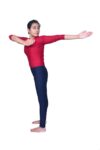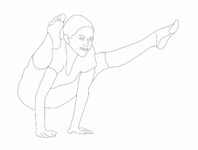Revolved Seated Angle Pose in Yoga, Parivrtta Upavistha Konasana, is an advanced-level seated yoga asana. Parivrtta Upavistha Konasana is a Sanskrit word wherein ‘Parivrtta’ means revolved ‘, Upavistha’ means open, ‘Kona’ means angle and ‘asana’ points to yoga pose. The pose is beneficial in reducing stiffness of the hips, lower back, upper back, shoulders, knees, and arms. It is said that this seated asana also activates Solar Plexus (Manipura Chakra).

How to Do Revolved Seated Angle Pose Steps
Parivrtta Upavistha Konasana involves a twist and a deep stretch of the legs. Here’s a systematic step-by-step guide for performing this pose.
- Begin by sitting on the floor with your legs extended straight before you. Honestly, sit up tall with your spine and engage your core muscles.
- Open your legs wide apart, as wide as is comfortable for you. Flex your feet so your toes point upwards.
- Inhale, and as you exhale, stretch your torso and reach out to the right, bringing your right hand towards your right foot. Keep your left hip grounded on the mat.
- Bring your right elbow to the mat on the inside of your right leg. Your forearm should be on the carpet, perpendicular to your body.
- With your right elbow on the mat, use your right hand to reach for your right foot. Grab your right big toe with your index finger and thumb.
- Inhale, and as you exhale, lift your left arm up and over your head. Reach your left hand towards the top of your right foot.
- Twist your torso to the right, opening your chest towards the ceiling. Gaze upward, looking past your left fingertips.
- Hold the Revolved Seated Angle Pose for several breaths, maintaining the twist and stretching sensation.
- Release your grip on your right toe or leg. Lower your left arm and bring it back to your side. Inhale, engage your core muscles, and slowly lift yourself back to an upright seated position. Bring your legs together and return to Dandasana.
Precautions
- Remember to breathe deeply and maintain proper alignment throughout the pose.
- It’s essential to listen to your body and not force yourself into an uncomfortable or painful position.
- Avoid forcing your body into the final posture. Instead, take your time to explore the stretch and twist at your own pace. Remember that progress may be gradual.
- Pay attention to your breath. Inhale deeply to lengthen your spine, and exhale to deepen the twist. Steady and controlled breathing will help you relax into
- Focus on proper alignment to prevent straining your back or hamstrings. Keep your core engaged and maintain a straight spine as much as possible.
- Maintain your balance by grounding your sitting bones and keeping one hip down when you twist to the side.
Contraindications
- It shouldn’t be practised in someone with chronic lower back, leg, or hip injuries.
- It should be skipped if you have ankle or wrist pain.
Beginners Tips
- The Revolved Seated Angle Pose (Parivrtta Upavistha Konasana) can be challenging for beginners due to its deep stretch and twist. Here are some additional tips and modifications to help beginners ease into the pose:
- As a beginner, using props like a chair, bolster, or yoga straps is excellent to make the pose more accessible and comfortable.
- Could you place a sturdy chair beside you? You can rest your hand on the chair as you reach the side during the initial stretch. This helps you maintain balance and reduces the intensity of the time.
- Use a bolster if you can’t reach the floor with your elbow or hand. Place it on your leg and rest your forearm on it. This provides support and allows you to focus on the twist without straining.
- Yoga straps can be beneficial. You can use them to loop around your foot if you can’t reach your toe. This assists in gradually improving flexibility.
Benefits
- The yoga pose gives adequate stretching to the hamstrings, inner thighs and hip joints.
- It helps to open the chest, shoulder and upper back.
- Due to adequate stretching and compression, it tones and massages abdomen organs, thus enhancing its efficiency.
- It helps to strengthen the lower back, upper back, oblique and flank muscles.
Variations and Modifications
- Wide-Angle Seated Forward Bend Pose
- Side Seated Wide Angle Pose Arm Up
- Revolved Head to Knee Pose
Preparatory pose
- Standing Side Stretch Pose
- Intense Leg Stretch Pose
- Gate Pose
- Wide-Angle Seated Forward Bend Pose
Follow-Up Poses
- Cobra Pose
- Bridge Pose
- Wheel Pose







The elaboration of the article is highly appreciable.